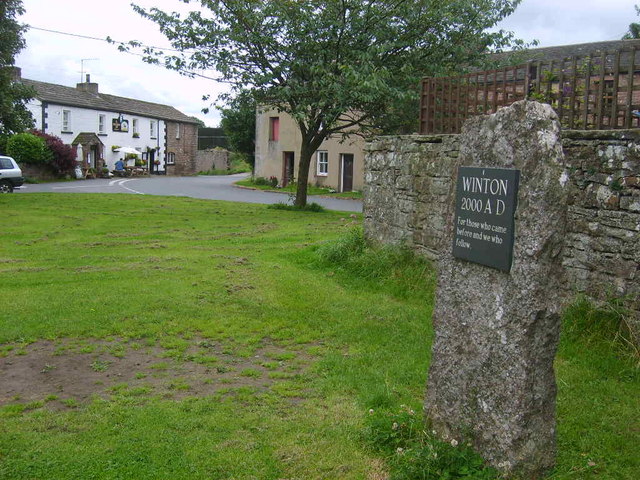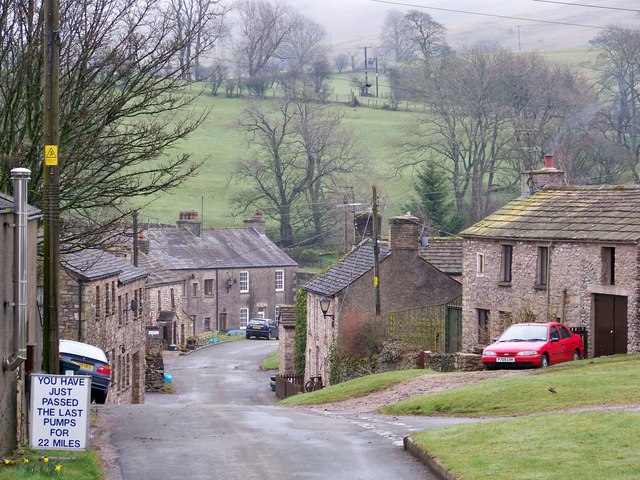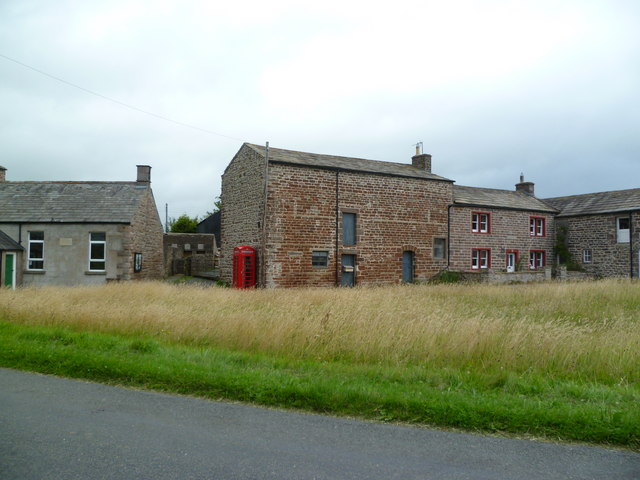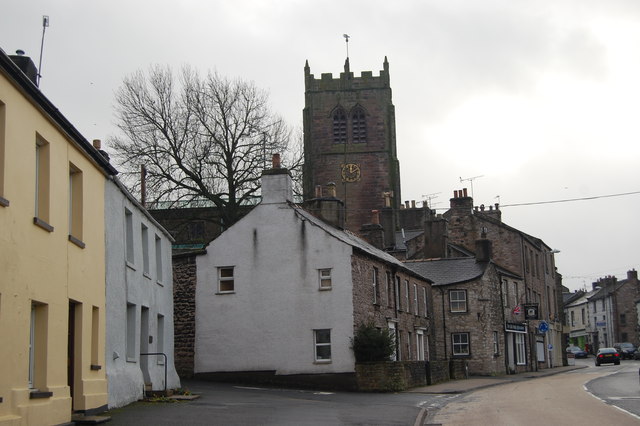Topics > Civil Parishes in Cumbria > Kirkby Stephen Town Council Area > Kirkby Stephen Parish, 1848
Kirkby Stephen Parish, 1848
KIRKBY-STEPHEN (St. Stephen), a market-town and parish, in East ward and union, county of Westmorland; comprising the townships of Hartley, Kaber, Kirkby-Stephen, Nateby, Smardale, Waitby, Wharton, and Winton, and the chapelries of Mallerstang and Soulby; and containing 2,850 inhabitants, of whom 1,345 are in the township of Kirkby-Stephen, 4 miles (S.S.W.) from Brough, 11 (S.E. by S.) from Appleby, and 265 (N.N.W.) from London. This town, which derives the adjunct to its name from the saint to whom its church is dedicated, is pleasantly situated in a fertile plain, on the western bank of the river Eden, opposite the hills that separate this county from Yorkshire. It consists of one good street; the houses are well built, and the town is abundantly supplied with water. The inhabitants are partly employed in the woollen manufacture, and in knitting stockings; great quantities of stockings were formerly exposed for sale at the market, but the trade in this article is on the decline. There is a manufactory for spinning and carding wool. The market is on Monday, for corn, flour, oatmeal, and provisions. Fairs are held on the Monday before Shrove-Tuesday, and the Monday before March 20th, April 25th, and Oct. 2nd, for horned-cattle, horses, woollen-cloth, blankets, cotton goods, &c.; on Sept. 27th, chiefly for horses; and on October 29th, for cattle and sheep. There are fairs for hiring servants on the last Monday in June and the first Monday in July. On the north side of the market-place, which is spacious and convenient, is a market-house, erected in 1810, in pursuance of the will of Mr. John Waller. The county magistrates hold petty-sessions here once a month, and special sessions as often as required.
The parish comprises by computation 31,870 acres of land, of which the soil is in some parts fertile; the substratum is rich in mineral produce, and mines of copper, lead, and coal are in operation, but the coal-mines are not very productive. The living is a vicarage, valued in the king's books at £48. 19. 2.; net income, £356; patron, H. King, Esq.; impropriators, the Earl of Lonsdale, Sir George Musgrave, Bart., and others. The church is an ancient and spacious building, with a lofty tower, and contains sepulchral chapels belonging to Smardale Hall, Wharton Hall, and Hartley Castle. In the second of these is a fine alabaster monument with the effigies of Thomas, Lord Wharton, and his first and second wives; and in the last is a monumental figure of a man in armour, supposed to have been erected to the memory of Sir Andrew Harcla, Earl of Carlisle, and governor of Hartley Castle, who was beheaded for treason in the reign of Edward II. There are chapels at Soulby and Mallerstang; and places of worship in the parish for Independents and Wesleyans. The free grammar school, held in an ancient edifice formerly the rectoryhouse, was founded in the 8th of Elizabeth, by Thomas, Lord Wharton, and endowed with property producing £40 per annum.
Extract from: A Topographical Dictionary of England comprising the several counties, cities, boroughs, corporate and market towns, parishes, and townships..... 7th Edition, by Samuel Lewis, London, 1848.

Co-Curate Page
Wharton Township, Westmorland, 1848
- WHARTON, a township, in the parish of Kirkby Stephen, East ward and union, county of Westmorland, 2¼ miles (S. by W.) from Kirkby-Stephen; containing 55 inhabitants. It comprises 1,472 acres, …

Co-Curate Page
Smardale Township, 1848
- SMARDALE, a township, in the parish of Kirkby Stephen, East ward and union, county of Westmorland, 2¾ miles (W.S.W.) from Kirkby-Stephen; containing 35 inhabitants. It comprises 1,735 acres, of which …

Co-Curate Page
Mallerstang Township, 1848
- MALLERSTANG, a chapelry, in the parish of Kirkby-Stephen, East ward and union, county of Westmorland, 3 miles (S. by E.) from Kirkby-Stephen; containing 223 inhabitants. The township comprises 4,944 acres, …

Co-Curate Page
Soulby (Kirkby Stephen)
- SOULBY, a chapelry, in the parish of Kirkby Stephen, East ward and union, county of Westmorland, 4 miles (S.W. by W.) from Brough; containing 300 inhabitants. It comprises 2,475a. 2r. …

Co-Curate Page
Waitby Township, 1848
- WAITBY, a township, in the parish of Kirkby Stephen, East ward and union, county of Westmorland, 1¾ mile (W.) from Kirkby-Stephen; containing 54 inhabitants. It comprises 972 acres, of which …

Co-Curate Page
Winton
- Overview About Winton Map Street View Winton is a village in the old Eden district of Cumbria, located about 1½ miles north-east of Kirkby Stephen and 2½ miles south-west of …

Co-Curate Page
Hartley
- Overview Map Street View Hartley is a village in the Eden district of Cumbria, located about ½ mile east of Kirkby Stephen. Historically, Hartley was a township in the ancient …

Co-Curate Page
Nateby
- Overview About Nateby Map Street View Nateby is a village in the Eden district of Cumbria, located about 1½ miles from the town of Kirkby Stephen. Historically, Nateby was a …

Co-Curate Page
Kaber, Cumbria
- Overview About Kaber Map Street View Kaber is a village in the Eden district of Cumbria, situated by Popping Beck and located about 2 miles south of Brough and 2 …


Co-Curate Page
Wharton Township, Westmorland, 1848
- WHARTON, a township, in the parish of Kirkby Stephen, East ward and union, county of Westmorland, 2¼ miles (S. by W.) from Kirkby-Stephen; containing 55 inhabitants. It comprises 1,472 acres, …

Co-Curate Page
Smardale Township, 1848
- SMARDALE, a township, in the parish of Kirkby Stephen, East ward and union, county of Westmorland, 2¾ miles (W.S.W.) from Kirkby-Stephen; containing 35 inhabitants. It comprises 1,735 acres, of which …

Co-Curate Page
Mallerstang Township, 1848
- MALLERSTANG, a chapelry, in the parish of Kirkby-Stephen, East ward and union, county of Westmorland, 3 miles (S. by E.) from Kirkby-Stephen; containing 223 inhabitants. The township comprises 4,944 acres, …

Co-Curate Page
Soulby (Kirkby Stephen)
- SOULBY, a chapelry, in the parish of Kirkby Stephen, East ward and union, county of Westmorland, 4 miles (S.W. by W.) from Brough; containing 300 inhabitants. It comprises 2,475a. 2r. …

Co-Curate Page
Waitby Township, 1848
- WAITBY, a township, in the parish of Kirkby Stephen, East ward and union, county of Westmorland, 1¾ mile (W.) from Kirkby-Stephen; containing 54 inhabitants. It comprises 972 acres, of which …

Co-Curate Page
Winton
- Overview About Winton Map Street View Winton is a village in the old Eden district of Cumbria, located about 1½ miles north-east of Kirkby Stephen and 2½ miles south-west of …

Co-Curate Page
Hartley
- Overview Map Street View Hartley is a village in the Eden district of Cumbria, located about ½ mile east of Kirkby Stephen. Historically, Hartley was a township in the ancient …

Co-Curate Page
Nateby
- Overview About Nateby Map Street View Nateby is a village in the Eden district of Cumbria, located about 1½ miles from the town of Kirkby Stephen. Historically, Nateby was a …








